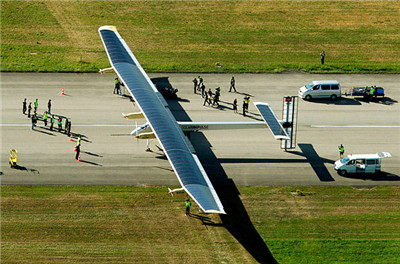(单词翻译:单击)
TOKYO — A solar-powered plane attempting to circle the globe without a drop of fuel made an unscheduled landing late Monday in Japan to wait out bad weather.
一架正在尝试不用一滴燃油环绕地球的太阳能飞机于周一晚间在日本临时降落,以便等待糟糕天气的结束。
Swiss pilot André Borschberg took off from Nanjing, China, on Sunday on what was to be the longest leg of the journey, a six-day, 8,175-kilometer (5,079-mile) flight to Hawaii.
瑞士飞行员安德烈·波许博格(André Borschberg)周日从中国的南京出发,开始了原本是航程中最长的一段飞行,计划用6天时间飞越5079英里(约合8175公里)到达夏威夷。

Instead, the Solar Impulse 2 made an unscheduled visit in central Japan, and landed safely at the Nagoya Airport.
但是,“阳光动力2号”(Solar Impulse 2)临时飞到了日本中部,在名古屋飞行场安全降落。
Japanese Transport Ministry and Nagoya airport officials said earlier that they were arranging for the landing to occur after the airport's usual closing hours to accommodate the plane with a wide wingspan.
日本国土交通省和机场的官员之前表示,他们一直在安排“阳光动力2号”在机场营业时间结束后的降落事宜,以使这架宽翼展的飞机能够顺利落地。
Live Internet feed on the organizers' website showed crewmembers in the control room applauding and cheering at the landing. Borschberg, who emerged from the cockpit with a full smile, was mobbed by the project's ground staff welcoming his safe arrival.
组织者网站上的直播视频显示,飞机着陆之际,控制室的机组人员在鼓掌欢呼。波许博格从驾驶舱中出来的时候满面笑容,被欢迎他安全抵达的项目地面工作人员团团围住。
Bertrand Piccard, Initiator, Chairman and Co-Pilot of Solar Impulse 2, told the organizer's live feed, Solar Impulse TV that it was unfortunate the weather turned bad when the flight was going very well. He said the plane will continue its journey to Hawaii when the weather improves.
“阳光动力2号”项目的发起人、董事长和副驾驶贝特朗·皮卡尔(Bertrand Piccard)在阳光动力电视的网络直播中表示,很可惜天气变恶劣了,尽管飞机一直飞得很好。他说天气转好时,飞机会继续前往夏威夷。
"You know, it's one of these strange moments of life between elation and disappointment," he said. The team has achieved the longest flight ever of a solar plane going through the night, but the front is too dangerous to cross ..."
“你知道,这就是生命中那种奇特的时刻,喜悦和失望兼有,”他说。“团队已经打破了太阳能飞机有史以来夜间飞行时间最长的记录,但是锋线太危险了,无法穿越……”
"It's just the weather doesn't fit. Everything we could do has been done and was successful. What we cannot control is the weather. So we land in Nagoya, we wait for better conditions, and we continue," he said.
“就是天公不作美。我们能做的都已经做了,也很成功。就是天气我们控制不了。所以我们降落在了名古屋,等天气转好再继续飞,”他说。
Elke Neumann, a spokeswoman for the Solar Impulse project, said from Nanjing that the team had noticed the weather more than a day ago.
“阳光动力”项目的发言人埃尔卡·诺伊曼(Elke Neumann)在南京表示,团队一天多前就注意到了这种天气。
"We thought we might go through it," she said. "But between Japan and Hawaii there's no place to stop."
“我们以为也许能挺过去,”她说。“但是日本和夏威夷之间没有地方可以停。”
The safety of the pilot and the plane are a priority, and they will likely wait a few days in Japan until the weather changes, she said.
她说,飞行员和飞机的安全是最重要的,而他们很可能得在日本等几天,直到天气状况改变。
Solar Impulse 2 needs room to land, so it generally avoids times when commercial flights are operating, Neuman said. The plane also usually lands at night, because the winds tend to be lower. It needs wind to be no more than 10 knots, she said.
诺伊曼称,“阳光动力2号”需要一定的空间来降落,所以一般会避开商业航班运行的时间。这架飞机还通常在夜间着陆,因为此时的风速往往比较低。她说,“阳光动力2号”承受的风速不能超过10节。
"We are a little bit sad, because everything's functioning perfectly: The batteries are charging, there's enough sun, the pilot is in good health, he's in good condition — it's all working well," Neumann said.
“我们有点儿难过,因为一切都运行完美:电池在蓄电,阳光充足,飞行员健康状况良好,状态也好——方方面面都不错,”诺伊曼说。
At the time of landing, the plane's batteries were still 74 percent charged, according to the organizer website.
组织者的网站上显示,飞机降落时,电池还有74%的电量。
The journey started in March in Abu Dhabi, and the plane has stopped in Oman, India, Myanmar and China. The flight from Nanjing to Hawaii is the seventh of 12 flights and the riskiest.
“阳光动力2号”于今年3月从阿布扎比启航,已在阿曼、印度、缅甸和中国经停。从南京到夏威夷是12个航段中的第七段,也是最危险的一段。


